

BENGALURU: Earlier this Monday, members of the Karnataka Rakshana Vedike held a protest in Bengaluru, against Amul’s supposed ‘merger’ with Nandini. The agitators were seen flinging Amul’s products on the streets, while raising slogans on how these items would not be permitted in the State. The group leader said the Gujarat-based cooperative was playing with the emotions of Karnataka’s citizens and that Kannadigas will not let Nandini collapse.
Amul’s entry into the Bengaluru market has spilled over into a political slugfest. The Opposition Congress and the Janata Dal (S) called out the BJP for attempting to shake the foundation of the Karnataka Milk Federation, something CM Basavaraj Bommai attempted to address by relegating such remarks to mere misinformation that is misleading milk producers and the public. A few members of the polity had recalled how the BJP had previously tried to flatten KMF in 2008 as well, by permitting Amul to make inroads into the State.
Amul went on the defensive, claiming its foray was not an attempt to compete with Nandini, but to cater to a niche market with its offerings of fresh milk and curd on e-commerce platforms, as opposed to mass distribution. However, this was regarded as a breach of an implicit trust between two well-to-do cooperatives to refrain from stepping on each other’s toes in their home markets. The developments are transpiring in Karnataka, a poll-bound State, where the issue of milk distribution has assumed the dimensions of regional pride. The Old Mysore region, a political tinderbox, whose electorate comprises a dominant, and significantly agrarian community – the Vokkaligas is now being coveted by the ruling dispensation.
Last December, Home Minister Amit Shah had addressed people in Mandya, a Vokkaliga hub, emphasising how there was a need for synergy between KMF and Amul to push the Indian dairy industry to the next level. He had even spoken about merging five cooperative societies with Amul, which was viewed as a way for Amul to gobble up Karnataka’s homegrown brand. Allegations were subsequently levelled at the Karnataka government for deliberately mismanaging the KMF, which created the ‘illusion’ of milk shortage for as long as one week.
But this is not a controversy endemic to Karnataka. South India’s lactose intolerance is on overdrive. Here in TN, the State-run Aavin had categorically stated last month that it will not use the Hindi term ‘dahi’ in its printed sachets, as instructed by the Food Safety and Standards Authority of India (FSSAI). The Tamil Nadu Cooperative Milk Producers Federation went on to say that it would only stick to the Tamil word ‘thayir’ to denote the product. Even Chief Minister M K Stalin had also decried the move as an attempt to impose Hindi down the throats of Tamilians.
In fact, the FSSAI had directed the KMF to use the Kannada equivalent for curd ‘mosaru’ in brackets, while urging TN to use ‘thayir’ in brackets for the labelling. In the aftermath of backlash from all the milk federations involved, including those from Karnataka, Kerala and TN, the FSSAI issued a clarification on labelling curd, as per which sellers are allowed to use the word ‘curd’ along with any other prevalent regional term in brackets. In Karnataka, there are over 28 lakh individuals attached to milk societies. As a vote bank, they make up a formidable 50 lakh strong base. And they are instrumental to BJP’s aspirations of conquering the Vokkaliga belt. The Congress as well as the JD(S) will attempt to milk the aforementioned issue that will dominate the political narrative in the days to come. The ruling party is now faced with a tightrope act to steer clear of the controversy so that it can hold on to power following the May 10 assembly polls.
Visit news.dtnext.in to explore our interactive epaper!
Download the DT Next app for more exciting features!
Click here for iOS
Click here for Android